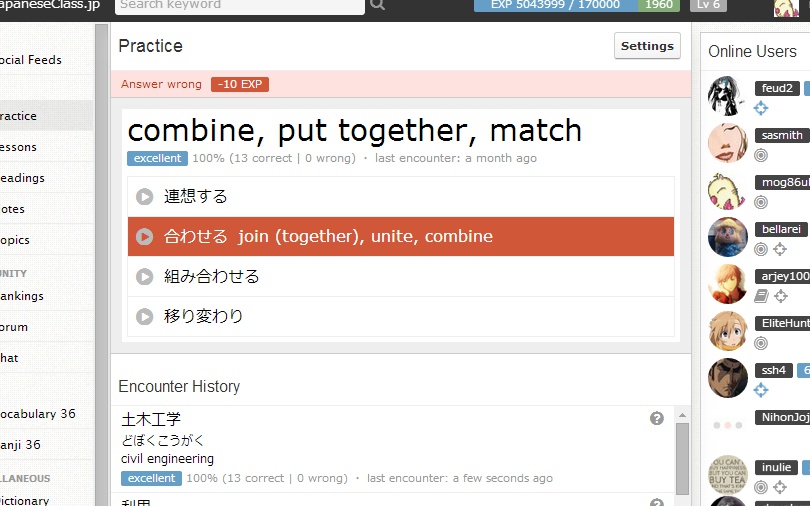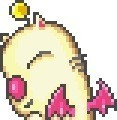Encountered this earlier. Probably the most harsh question I've come across now. ;_; - Feed Post by mog86uk
Encountered this earlier. Probably the most harsh question I've come across now. ;_;
The answer I clicked means all those things in the question, but I don't always think to check further down the list if I find a correct answer. I don't really understand the difference in meaning between 合わせる and 組み合わせる, but I guess maybe the latter is more specific than the former? Bleh...

The answer I clicked means all those things in the question, but I don't always think to check further down the list if I find a correct answer. I don't really understand the difference in meaning between 合わせる and 組み合わせる, but I guess maybe the latter is more specific than the former? Bleh...

posted by mog86uk November 14, 2014 at 1:21pm
Comments 17
 He he, that ones nasty. I'm guessing that 合わせる is more like 2 people meeting where as 組み合わせる is more literal like combining to threads? If anyone knows for sure I'd be interested as well ^^November 14, 2014 at 1:27pm
He he, that ones nasty. I'm guessing that 合わせる is more like 2 people meeting where as 組み合わせる is more literal like combining to threads? If anyone knows for sure I'd be interested as well ^^November 14, 2014 at 1:27pm Yeah, the main reason I posted this is because I'm hoping someone might be able to explain the difference. I'm interested too. :)
Yeah, the main reason I posted this is because I'm hoping someone might be able to explain the difference. I'm interested too. :)
I don't think this is actually the most harsh question. I still think the following one was worse...
http://japaneseclass.jp/assets/photos/mog86uk430592.jpg
(nostalgia trip back to ye olden days!)November 14, 2014 at 1:39pm lol I don't remember the site ever looking like that, so it's before I joined. Also whenever these pop up now I just refresh :3November 14, 2014 at 1:52pm
lol I don't remember the site ever looking like that, so it's before I joined. Also whenever these pop up now I just refresh :3November 14, 2014 at 1:52pm I don't like using refresh, every time I refresh I then have to go back into "Settings" and uncheck "show kana" (as you can see in my screenshot). Also, I nearly always uncheck "level 1" because I get 0 exp on every single level 1 question (as I've answered every level 1 item more than 29 times).
I don't like using refresh, every time I refresh I then have to go back into "Settings" and uncheck "show kana" (as you can see in my screenshot). Also, I nearly always uncheck "level 1" because I get 0 exp on every single level 1 question (as I've answered every level 1 item more than 29 times).
A better idea is to click "Settings" and then click "Save settings" without actually changing anything. ^^November 14, 2014 at 2:17pm Oh I didn't know that worked as well, ty.November 14, 2014 at 2:41pm
Oh I didn't know that worked as well, ty.November 14, 2014 at 2:41pm How do you read the longer one? not the awaseru one. the other one you're typing....ugggh I can't type in japanese...annoyingNovember 19, 2014 at 9:03am
How do you read the longer one? not the awaseru one. the other one you're typing....ugggh I can't type in japanese...annoyingNovember 19, 2014 at 9:03am 合わせる = あわせる
合わせる = あわせる
組み合わせる = くみあわせる
組み (くみ) is a conjugated form of the verb 組む (くむ). When used as a noun, it is normally written as just the kanji alone 組 (くみ) without the okurigana.
If you're on a computer, you should definitely try to get Japanese input installed. Typing hiragana is as simple as typing romaji, as all you are doing is typing romaji and it automatically converts to hiragana.
It's pretty simple to install too. Google's Japanese input is the simplest and best, and it takes only a minute or so to download and install, and then it's immediately visible on your language bar ready to use! ^^
Here's the download page:
https://tools.google.com/dlpage/japaneseinput/eula.html?hl=enNovember 19, 2014 at 10:58am 組むってなの意味ですか.(Please feel free to correct my grammar)
組むってなの意味ですか.(Please feel free to correct my grammar)
エンギリスで住んでいますか。どこで?僕はStoke-on-Trent で住んでいる。
やっと日本語でかけます(I don't know the verb for type...lol). 助かりました。本当にありがとうNovember 19, 2014 at 8:40pm Nice, you have Japanese input working. :)
Nice, you have Japanese input working. :)
僕はHampshireに住んでいます。
I'm guessing you meant "組むって何の意味ですか"?
__って + な + の + 意味... that doesn't make sense having な there, probably meant to type "なん"?
I've completely ignored studying grammar for the last few months, so I'm not even sure. I'm rushing as I've gotta head off to work. :P
Oh yeah, イングランド is probably another word you were looking for. Although I don't know how much this is used in Japan, as I normally see イギリス and 英国 used, but it is definitely in dictionaries. See you later. :)November 21, 2014 at 1:37am I meant to type IGIRISU. I don't know why I typed INGIRISU. I know 英国 but I've never come across イングランド.
I meant to type IGIRISU. I don't know why I typed INGIRISU. I know 英国 but I've never come across イングランド.
Yeah thanks for the link. It works like a charm now. I tried another way before that but I couldn't type.
Thanks for the correction! It's certainly wrong to say なの意味。I think I should have said 組むっての意味はをなんですか?
The 組むって何の意味ですか? goes over my head right now. Maybe because I'm tired from work, but I can't understand if that's grammatically correct. の is either possesive or is used to seek or provide an explanation. I can't understand it's use in this sentence.
November 21, 2014 at 6:50am oh god that's wrong...lol
oh god that's wrong...lol
組むっての意味はなんですか? I meant...lol :)November 21, 2014 at 6:52am > "組むっての意味はをなんですか?"
> "組むっての意味はをなんですか?"
That one is definitely worse, especially the は + を, and the を to mark a direct object even without a lexical verb to act on it.
> "組むっての意味はなんですか?"
This sentence still has problems.
って is a particle which is basically short for と + は.
Using の after the は particle would be very odd, so it must be wrong after って too. And then also using は again shortly after って (とは)...
I think I would probably just try saying it like use this:
「組み」の意味はなんですか?
But this might be a better way, closer to the way you wrote it:
組みって、どういう意味ですか?November 21, 2014 at 10:27am Aaaah, thanks for the help.
Aaaah, thanks for the help.
Let's not speak about this sentence 組むっての意味はをなんですか?
It made me wonder how I wrote that. The を is just wrong there.
I was seriously clueless regarding this kanji. I thought the むって part of 組むって was okurigana but I can see that I was the one who typed this in the first place yet I'm not aware and I don't know how to use either って or と + は. I know what と and は mean and how they're used but I don't know if they mean something different when used together. Sorry to bother you really, I just didn't realise I was so clueless.November 22, 2014 at 7:47am 「組み」の意味はなんですか? is a very simply way of saying it and easy as well.
「組み」の意味はなんですか? is a very simply way of saying it and easy as well.
どういう意味ですか?I find this structure easy as well. I just don't understand the とは
November 22, 2014 at 7:49am simple I meant. I think I need to be employed as a proofreader. jesus...November 22, 2014 at 7:49am
simple I meant. I think I need to be employed as a proofreader. jesus...November 22, 2014 at 7:49am I already read your reply but the site kept being offline when I was trying to post a response.
I already read your reply but the site kept being offline when I was trying to post a response.
と+は is easy enough to understand. After using と to mark the quotation, if you need to make that the subject you can add は to it like you would normally do. Doesn't have any special meaning using the two together, just their normal purposes.
I don't really understand "って" terribly well though. When I said it is short for と+は, that was just what I thought it was from memory. I've now seen some web pages saying that って is actually short for と言う (と+いう), which is something I remember reading about before.
って can be used to introduce subjects in a similar way to と+は though, and according to this dictionary link, it can mean something like というのは:
http://dictionary.goo.ne.jp/leaf/jn2/147762/m0u/って/
That link mentions the と+いう thing too. Goo Jisho is all in Japanese and is hard to read, but I realise now how powerful and accurate that dictionary is. I can already read most of the Japanese grammar terminology, so I think I'm going to put in some effort to learn to be fully able to read that dictionary properly. :)November 24, 2014 at 7:37am Forgot that links on this site don't accept Japanese characters. Here's a working link:
Forgot that links on this site don't accept Japanese characters. Here's a working link:
http://dictionary.goo.ne.jp/leaf/jn2/147762/m0u/%E3%81%A3%E3%81%A6/November 24, 2014 at 7:39am
